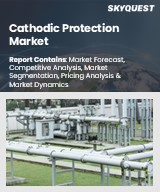
|
시장보고서
상품코드
1881746
석유 및 가스 부식 방지 시장 : 세계 산업 규모, 점유율, 동향, 기회, 예측 - 유형별, 설치 장소별, 부문별, 지역별, 경쟁별(2020-2030년)Oil and Gas Corrosion Protection Market - Global Industry Size, Share, Trends, Opportunity, & Forecast, Segmented By Type, By Location, By Sector, By Region and Competition, 2020-2030F |
||||||
세계의 석유 및 가스 부식 방지 시장은 2024년에 107억 8,000만 달러로 평가되었으며, 2030년까지 CAGR 4.1%로 성장하여 137억 2,000만 달러에 달할 것으로 예측됩니다.
세계 석유 및 가스 부식 방지 시장은 파이프라인, 저장 탱크, 해양 플랫폼과 같은 핵심 인프라를 부식성 요소로부터 보호하거나 열화를 줄이기 위해 설계된 전문 시스템, 재료 및 서비스로 구성되어 있습니다. 이 시장의 성장은 주로 기존 석유 및 가스 자산의 광범위한 노후화, 점점 더 엄격해지는 안전 및 환경 규제에 대한 대응 필요성, 그리고 지리적으로 까다롭고 열악한 운영 환경에서 지속적인 탐사 및 생산 활동으로 인해 주도되고 있습니다.
| 시장 개요 | |
|---|---|
| 예측 기간 | 2026-2030년 |
| 시장 규모 : 2024년 | 107억 8,000만 달러 |
| 시장 규모 : 2030년 | 137억 2,000만 달러 |
| CAGR : 2025-2030년 | 4.1% |
| 가장 빠르게 성장하는 부문 | 오프쇼어 |
| 최대 시장 | 아시아태평양 |
주요 시장 촉진요인
석유 및 가스 인프라의 노후화라는 광범위한 과제는 세계 부식 방지 시장의 주요 촉진요인으로 작용하고 있습니다. 파이프라인, 해양 플랫폼, 정제 장치 등 중요한 자산이 당초 설계 수명을 초과함에 따라 부식에 대한 취약성이 증가함에 따라 지속적이고 전문적인 보호 조치가 요구되고 있습니다.
주요 시장 과제
종합적인 부식 방지 시스템 도입에 필요한 막대한 설비투자는 시장 확대에 큰 걸림돌이 되고 있습니다. 이러한 재정적 부담으로 인해, 특히 노후화된 인프라나 경제 불안정기에 필요한 투자를 미루는 경우가 많으며, 이는 자산의 건전성과 가동 수명을 위험에 빠뜨리는 결과를 초래합니다.
주요 시장 동향
나노코팅 및 그래핀 기반 코팅의 발전은 우수한 재료 성능을 제공함으로써 전 세계 석유 및 가스 부식 방지 시장에 큰 영향을 미치고 있습니다. 이 혁신적인 코팅은 열악한 작업 환경에서 파이프라인 및 해양 플랫폼과 같은 중요한 인프라를 보호하는 데 필수적인 강화된 내구성, 내화학성 및 장벽 특성을 제공합니다.
자주 묻는 질문
목차
제1장 개요
제2장 조사 방법
제3장 주요 요약
제4장 고객의 소리
제5장 세계의 석유 및 가스 부식 방지 시장 전망
- 시장 규모 및 예측
- 금액별
- 시장 점유율과 예측
- 종류별(코팅, 페인트, 억제제, 기타)
- 설치 장소별(해상, 육상)
- 부문별(업스트림, 미드스트림, 다운스트림)
- 지역별
- 기업별(2024)
- 시장 맵
제6장 북미의 석유 및 가스 부식 방지 시장 전망
- 시장 규모 및 예측
- 시장 점유율과 예측
- 북미 : 국가별 분석
- 미국
- 캐나다
- 멕시코
제7장 유럽의 석유 및 가스 부식 방지 시장 전망
- 시장 규모 및 예측
- 시장 점유율과 예측
- 유럽 : 국가별 분석
- 독일
- 프랑스
- 영국
- 이탈리아
- 스페인
제8장 아시아태평양의 석유 및 가스 부식 방지 시장 전망
- 시장 규모 및 예측
- 시장 점유율과 예측
- 아시아태평양 : 국가별 분석
- 중국
- 인도
- 일본
- 한국
- 호주
제9장 중동 및 아프리카의 석유 및 가스 부식 방지 시장 전망
- 시장 규모 및 예측
- 시장 점유율과 예측
- 중동 및 아프리카 : 국가별 분석
- 사우디아라비아
- 아랍에미리트
- 남아프리카공화국
제10장 남미의 석유 및 가스 부식 방지 시장 전망
- 시장 규모 및 예측
- 시장 점유율과 예측
- 남미 : 국가별 분석
- 브라질
- 콜롬비아
- 아르헨티나
제11장 시장 역학
- 성장 촉진요인
- 과제
제12장 시장 동향과 발전
- 인수합병
- 제품 출시
- 최근 동향
제13장 세계의 석유 및 가스 부식 방지 시장 : SWOT 분석
제14장 Porter's Five Forces 분석
- 업계내 경쟁
- 신규 참여의 가능성
- 공급업체의 능력
- 고객의 능력
- 대체품의 위협
제15장 경쟁 구도
- 3M Company
- Akzo Nobel N.V.
- Hempel A/S
- BASF SE
- The Sherwin Williams Company
- RPM International, Inc
- Jotun A/S
- Chase Corporation
- Axalta Coating Systems, LLC
- Metal Coatings Corporation
제16장 전략적 제안
제17장 조사 회사 소개 및 면책사항
KSM 25.12.16The Global Oil and Gas Corrosion Protection Market, valued at USD 10.78 Billion in 2024, is projected to experience a CAGR of 4.1% to reach USD 13.72 Billion by 2030. The Global Oil and Gas Corrosion Protection Market comprises specialized systems, materials, and services engineered to prevent or mitigate the degradation of critical infrastructure, including pipelines, storage tanks, and offshore platforms, from corrosive elements. This market's growth is fundamentally driven by the extensive aging of existing oil and gas assets, the imperative to comply with increasingly stringent safety and environmental regulations, and the ongoing exploration and production activities in geographically challenging and harsher operating environments.
| Market Overview | |
|---|---|
| Forecast Period | 2026-2030 |
| Market Size 2024 | USD 10.78 Billion |
| Market Size 2030 | USD 13.72 Billion |
| CAGR 2025-2030 | 4.1% |
| Fastest Growing Segment | Offshore |
| Largest Market | Asia Pacific |
Key Market Drivers
The pervasive issue of aging oil and gas infrastructure stands as a primary driver for the global corrosion protection market. As vital assets such as pipelines, offshore platforms, and refining units exceed their initial design life, their vulnerability to corrosion intensifies, demanding continuous and specialized protective interventions. Such degradation necessitates advanced monitoring, maintenance, and material solutions to ensure operational safety and prevent environmental damage. According to Offshore Technology, in January 2025, Top Companies List of Asset Integrity Management in Global 2025, over 7% of oil and gas infrastructure is 30 years old or more, demonstrating the significant requirement for proactive corrosion management to extend asset operational lifespans.
Key Market Challenges
The substantial capital expenditure required for implementing comprehensive corrosion protection systems presents a notable impediment to market expansion. This financial burden frequently results in the deferral of essential investments, particularly for aging infrastructure or during periods of economic instability, thereby risking asset integrity and operational longevity. The increasing cost environment further exacerbates this challenge, compelling companies to prioritize capital allocation with greater scrutiny.
Key Market Trends
Advancements in Nanocoatings and Graphene-Based Coatings are significantly influencing the global oil and gas corrosion protection market by offering superior material performance. These innovative coatings provide enhanced durability, chemical resistance, and barrier properties, which are crucial for safeguarding critical infrastructure such as pipelines and offshore platforms in harsh operating environments. The ongoing development and deployment of these advanced materials enable a proactive approach to asset integrity, extending the operational lifespan of equipment and reducing the frequency of maintenance. For instance, in April 2025, Zentek completed successful testing of its ZenARMOR(TM) nano-pigment in military-grade aerospace paints, demonstrating strong corrosion inhibition under rigorous ASTM standards, and is collaborating with Jazeera Paints in Saudi Arabia to integrate this nanotechnology into corrosion protection products.
Key Market Players
- 3M Company
- Akzo Nobel N.V.
- Hempel A/S
- BASF SE
- The Sherwin Williams Company
- RPM International, Inc
- Jotun A/S
- Chase Corporation
- Axalta Coating Systems, LLC
- Metal Coatings Corporation
Report Scope:
In this report, the Global Oil and Gas Corrosion Protection Market has been segmented into the following categories, in addition to the industry trends which have also been detailed below:
Oil and Gas Corrosion Protection Market, By Type:
- Coatings
- Paints
- Inhibitors
- Others
Oil and Gas Corrosion Protection Market, By Location:
- Offshore
- Onshore
Oil and Gas Corrosion Protection Market, By Sector:
- Upstream
- Midstream
- Downstream
Oil and Gas Corrosion Protection Market, By Region:
- North America
- United States
- Canada
- Mexico
- Europe
- France
- United Kingdom
- Italy
- Germany
- Spain
- Asia Pacific
- China
- India
- Japan
- Australia
- South Korea
- South America
- Brazil
- Argentina
- Colombia
- Middle East & Africa
- South Africa
- Saudi Arabia
- UAE
Competitive Landscape
Company Profiles: Detailed analysis of the major companies presents in the Global Oil and Gas Corrosion Protection Market.
Available Customizations:
Global Oil and Gas Corrosion Protection Market report with the given market data, TechSci Research offers customizations according to a company's specific needs. The following customization options are available for the report:
Company Information
- Detailed analysis and profiling of additional market players (up to five).
Table of Contents
1. Product Overview
- 1.1. Market Definition
- 1.2. Scope of the Market
- 1.2.1. Markets Covered
- 1.2.2. Years Considered for Study
- 1.2.3. Key Market Segmentations
2. Research Methodology
- 2.1. Objective of the Study
- 2.2. Baseline Methodology
- 2.3. Key Industry Partners
- 2.4. Major Association and Secondary Sources
- 2.5. Forecasting Methodology
- 2.6. Data Triangulation & Validation
- 2.7. Assumptions and Limitations
3. Executive Summary
- 3.1. Overview of the Market
- 3.2. Overview of Key Market Segmentations
- 3.3. Overview of Key Market Players
- 3.4. Overview of Key Regions/Countries
- 3.5. Overview of Market Drivers, Challenges, Trends
4. Voice of Customer
5. Global Oil and Gas Corrosion Protection Market Outlook
- 5.1. Market Size & Forecast
- 5.1.1. By Value
- 5.2. Market Share & Forecast
- 5.2.1. By Type (Coatings, Paints, Inhibitors, Others)
- 5.2.2. By Location (Offshore, Onshore)
- 5.2.3. By Sector (Upstream, Midstream, Downstream)
- 5.2.4. By Region
- 5.2.5. By Company (2024)
- 5.3. Market Map
6. North America Oil and Gas Corrosion Protection Market Outlook
- 6.1. Market Size & Forecast
- 6.1.1. By Value
- 6.2. Market Share & Forecast
- 6.2.1. By Type
- 6.2.2. By Location
- 6.2.3. By Sector
- 6.2.4. By Country
- 6.3. North America: Country Analysis
- 6.3.1. United States Oil and Gas Corrosion Protection Market Outlook
- 6.3.1.1. Market Size & Forecast
- 6.3.1.1.1. By Value
- 6.3.1.2. Market Share & Forecast
- 6.3.1.2.1. By Type
- 6.3.1.2.2. By Location
- 6.3.1.2.3. By Sector
- 6.3.1.1. Market Size & Forecast
- 6.3.2. Canada Oil and Gas Corrosion Protection Market Outlook
- 6.3.2.1. Market Size & Forecast
- 6.3.2.1.1. By Value
- 6.3.2.2. Market Share & Forecast
- 6.3.2.2.1. By Type
- 6.3.2.2.2. By Location
- 6.3.2.2.3. By Sector
- 6.3.2.1. Market Size & Forecast
- 6.3.3. Mexico Oil and Gas Corrosion Protection Market Outlook
- 6.3.3.1. Market Size & Forecast
- 6.3.3.1.1. By Value
- 6.3.3.2. Market Share & Forecast
- 6.3.3.2.1. By Type
- 6.3.3.2.2. By Location
- 6.3.3.2.3. By Sector
- 6.3.3.1. Market Size & Forecast
- 6.3.1. United States Oil and Gas Corrosion Protection Market Outlook
7. Europe Oil and Gas Corrosion Protection Market Outlook
- 7.1. Market Size & Forecast
- 7.1.1. By Value
- 7.2. Market Share & Forecast
- 7.2.1. By Type
- 7.2.2. By Location
- 7.2.3. By Sector
- 7.2.4. By Country
- 7.3. Europe: Country Analysis
- 7.3.1. Germany Oil and Gas Corrosion Protection Market Outlook
- 7.3.1.1. Market Size & Forecast
- 7.3.1.1.1. By Value
- 7.3.1.2. Market Share & Forecast
- 7.3.1.2.1. By Type
- 7.3.1.2.2. By Location
- 7.3.1.2.3. By Sector
- 7.3.1.1. Market Size & Forecast
- 7.3.2. France Oil and Gas Corrosion Protection Market Outlook
- 7.3.2.1. Market Size & Forecast
- 7.3.2.1.1. By Value
- 7.3.2.2. Market Share & Forecast
- 7.3.2.2.1. By Type
- 7.3.2.2.2. By Location
- 7.3.2.2.3. By Sector
- 7.3.2.1. Market Size & Forecast
- 7.3.3. United Kingdom Oil and Gas Corrosion Protection Market Outlook
- 7.3.3.1. Market Size & Forecast
- 7.3.3.1.1. By Value
- 7.3.3.2. Market Share & Forecast
- 7.3.3.2.1. By Type
- 7.3.3.2.2. By Location
- 7.3.3.2.3. By Sector
- 7.3.3.1. Market Size & Forecast
- 7.3.4. Italy Oil and Gas Corrosion Protection Market Outlook
- 7.3.4.1. Market Size & Forecast
- 7.3.4.1.1. By Value
- 7.3.4.2. Market Share & Forecast
- 7.3.4.2.1. By Type
- 7.3.4.2.2. By Location
- 7.3.4.2.3. By Sector
- 7.3.4.1. Market Size & Forecast
- 7.3.5. Spain Oil and Gas Corrosion Protection Market Outlook
- 7.3.5.1. Market Size & Forecast
- 7.3.5.1.1. By Value
- 7.3.5.2. Market Share & Forecast
- 7.3.5.2.1. By Type
- 7.3.5.2.2. By Location
- 7.3.5.2.3. By Sector
- 7.3.5.1. Market Size & Forecast
- 7.3.1. Germany Oil and Gas Corrosion Protection Market Outlook
8. Asia Pacific Oil and Gas Corrosion Protection Market Outlook
- 8.1. Market Size & Forecast
- 8.1.1. By Value
- 8.2. Market Share & Forecast
- 8.2.1. By Type
- 8.2.2. By Location
- 8.2.3. By Sector
- 8.2.4. By Country
- 8.3. Asia Pacific: Country Analysis
- 8.3.1. China Oil and Gas Corrosion Protection Market Outlook
- 8.3.1.1. Market Size & Forecast
- 8.3.1.1.1. By Value
- 8.3.1.2. Market Share & Forecast
- 8.3.1.2.1. By Type
- 8.3.1.2.2. By Location
- 8.3.1.2.3. By Sector
- 8.3.1.1. Market Size & Forecast
- 8.3.2. India Oil and Gas Corrosion Protection Market Outlook
- 8.3.2.1. Market Size & Forecast
- 8.3.2.1.1. By Value
- 8.3.2.2. Market Share & Forecast
- 8.3.2.2.1. By Type
- 8.3.2.2.2. By Location
- 8.3.2.2.3. By Sector
- 8.3.2.1. Market Size & Forecast
- 8.3.3. Japan Oil and Gas Corrosion Protection Market Outlook
- 8.3.3.1. Market Size & Forecast
- 8.3.3.1.1. By Value
- 8.3.3.2. Market Share & Forecast
- 8.3.3.2.1. By Type
- 8.3.3.2.2. By Location
- 8.3.3.2.3. By Sector
- 8.3.3.1. Market Size & Forecast
- 8.3.4. South Korea Oil and Gas Corrosion Protection Market Outlook
- 8.3.4.1. Market Size & Forecast
- 8.3.4.1.1. By Value
- 8.3.4.2. Market Share & Forecast
- 8.3.4.2.1. By Type
- 8.3.4.2.2. By Location
- 8.3.4.2.3. By Sector
- 8.3.4.1. Market Size & Forecast
- 8.3.5. Australia Oil and Gas Corrosion Protection Market Outlook
- 8.3.5.1. Market Size & Forecast
- 8.3.5.1.1. By Value
- 8.3.5.2. Market Share & Forecast
- 8.3.5.2.1. By Type
- 8.3.5.2.2. By Location
- 8.3.5.2.3. By Sector
- 8.3.5.1. Market Size & Forecast
- 8.3.1. China Oil and Gas Corrosion Protection Market Outlook
9. Middle East & Africa Oil and Gas Corrosion Protection Market Outlook
- 9.1. Market Size & Forecast
- 9.1.1. By Value
- 9.2. Market Share & Forecast
- 9.2.1. By Type
- 9.2.2. By Location
- 9.2.3. By Sector
- 9.2.4. By Country
- 9.3. Middle East & Africa: Country Analysis
- 9.3.1. Saudi Arabia Oil and Gas Corrosion Protection Market Outlook
- 9.3.1.1. Market Size & Forecast
- 9.3.1.1.1. By Value
- 9.3.1.2. Market Share & Forecast
- 9.3.1.2.1. By Type
- 9.3.1.2.2. By Location
- 9.3.1.2.3. By Sector
- 9.3.1.1. Market Size & Forecast
- 9.3.2. UAE Oil and Gas Corrosion Protection Market Outlook
- 9.3.2.1. Market Size & Forecast
- 9.3.2.1.1. By Value
- 9.3.2.2. Market Share & Forecast
- 9.3.2.2.1. By Type
- 9.3.2.2.2. By Location
- 9.3.2.2.3. By Sector
- 9.3.2.1. Market Size & Forecast
- 9.3.3. South Africa Oil and Gas Corrosion Protection Market Outlook
- 9.3.3.1. Market Size & Forecast
- 9.3.3.1.1. By Value
- 9.3.3.2. Market Share & Forecast
- 9.3.3.2.1. By Type
- 9.3.3.2.2. By Location
- 9.3.3.2.3. By Sector
- 9.3.3.1. Market Size & Forecast
- 9.3.1. Saudi Arabia Oil and Gas Corrosion Protection Market Outlook
10. South America Oil and Gas Corrosion Protection Market Outlook
- 10.1. Market Size & Forecast
- 10.1.1. By Value
- 10.2. Market Share & Forecast
- 10.2.1. By Type
- 10.2.2. By Location
- 10.2.3. By Sector
- 10.2.4. By Country
- 10.3. South America: Country Analysis
- 10.3.1. Brazil Oil and Gas Corrosion Protection Market Outlook
- 10.3.1.1. Market Size & Forecast
- 10.3.1.1.1. By Value
- 10.3.1.2. Market Share & Forecast
- 10.3.1.2.1. By Type
- 10.3.1.2.2. By Location
- 10.3.1.2.3. By Sector
- 10.3.1.1. Market Size & Forecast
- 10.3.2. Colombia Oil and Gas Corrosion Protection Market Outlook
- 10.3.2.1. Market Size & Forecast
- 10.3.2.1.1. By Value
- 10.3.2.2. Market Share & Forecast
- 10.3.2.2.1. By Type
- 10.3.2.2.2. By Location
- 10.3.2.2.3. By Sector
- 10.3.2.1. Market Size & Forecast
- 10.3.3. Argentina Oil and Gas Corrosion Protection Market Outlook
- 10.3.3.1. Market Size & Forecast
- 10.3.3.1.1. By Value
- 10.3.3.2. Market Share & Forecast
- 10.3.3.2.1. By Type
- 10.3.3.2.2. By Location
- 10.3.3.2.3. By Sector
- 10.3.3.1. Market Size & Forecast
- 10.3.1. Brazil Oil and Gas Corrosion Protection Market Outlook
11. Market Dynamics
- 11.1. Drivers
- 11.2. Challenges
12. Market Trends & Developments
- 12.1. Merger & Acquisition (If Any)
- 12.2. Product Launches (If Any)
- 12.3. Recent Developments
13. Global Oil and Gas Corrosion Protection Market: SWOT Analysis
14. Porter's Five Forces Analysis
- 14.1. Competition in the Industry
- 14.2. Potential of New Entrants
- 14.3. Power of Suppliers
- 14.4. Power of Customers
- 14.5. Threat of Substitute Products
15. Competitive Landscape
- 15.1. 3M Company
- 15.1.1. Business Overview
- 15.1.2. Products & Services
- 15.1.3. Recent Developments
- 15.1.4. Key Personnel
- 15.1.5. SWOT Analysis
- 15.2. Akzo Nobel N.V.
- 15.3. Hempel A/S
- 15.4. BASF SE
- 15.5. The Sherwin Williams Company
- 15.6. RPM International, Inc
- 15.7. Jotun A/S
- 15.8. Chase Corporation
- 15.9. Axalta Coating Systems, LLC
- 15.10. Metal Coatings Corporation



















